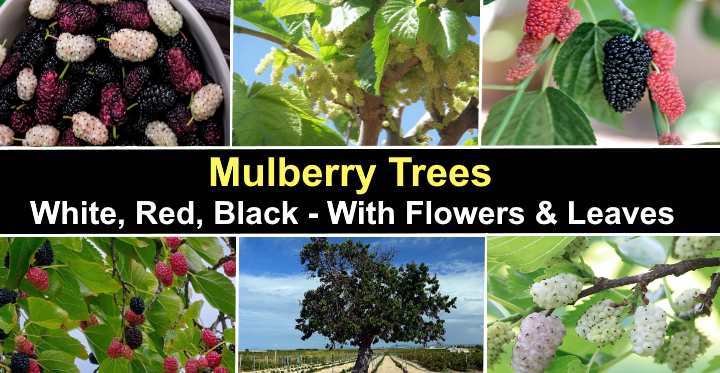Mulberry trees (botanical name Morus) are lovely decorative shade trees that produce rich, sweet, or black berries. The medium-sized, berry-producing trees have beautiful heart-shaped leaves, catkins of tiny white flowers, and thick grayish-brown bark. They are commonly known as mulberries. Red mulberry, white mulberry, and black mulberry are the most common species of mulberry trees.
Mulberry trees are lovely trees that are simple to establish and produce deliciously sweet berries, which makes them popular in garden settings. USDA zones 4 through 9, full to partial sun, and well-drained soils are ideal for the common mulberry.
The mulberry tree is also resistant to insect and disease attacks. In a landscape, how can you tell which mulberry trees? Mulberries are attractive residential trees for a variety of reasons. This guide to growing mulberry trees answers common questions about identifying this fruit and how to cultivate it.
Common Types of Mulberry (Morus)
Mulberry trees are divided into three major species based on their fruit color, leaf form, and bark. In addition, weeping mulberry trees, fruitless mulberry trees, and dwarf mulberry trees are some of the many mulberry cultivars available. The following are brief descriptions of the most frequent mulberry trees:
Red mulberry (Morus rubra): Mulberries are indigenous to North America, and this species is found there. It thrives in moist, rich, well-draining soil. The crimson mulberry has small white spring blooms, sweet, juicy red or black berries, and leaves of various forms. It has a rounded crown, a short trunk, and tiny white blossoms.
White mulberry (Morus alba): The Far East is home to this mulberry species, but it’s also grown in Europe and North America. When immature, the blackberry-like edible fruits are white; as they mature, they turn pink or purple. Heart-shaped, serrated leaves characterize the white mulberry.
Black mulberry (Morus nigra): The black mulberry tree has heart-shaped serrated leaves and produces delicious mulberry berries. It is a deciduous, medium-sized fast-growing tree.
About Mulberry Trees

Mulberry is a deciduous tree in the Moraceae family of woody plants, and it belongs to the genus Morus. Mulberry trees are berry-producing trees that grow quickly and are suitable for most situations. The species determines the mulberry’s adult size. The tallest tree is 80 feet (24 meters) high, followed by 70 feet (21 meters) high by the common red mulberry.
With a height of around 30 feet (9 meters), the black mulberry is the tiniest species. The bushy plant grows 2 to 6 feet (0.6 to 1.8 meters) tall, making it ideal for containers for a smaller garden tree.
A mulberry tree is admired for its sweet, delicious fruits, in addition to its ornamental beauty. Mulberry berries resemble blackberries in appearance. Red and black mulberries produce sweeter berries than white mulberries. Black mulberries, on the other hand, are more prone to drought or frost damage. You seldom encounter mulberry berries in grocery stores because these soft mulberry fruits don’t travel well.
The monkey pursued the weasel in the childhood song “All Around the Mulberry Bush,” which many people remember. Mulberry bushes, on the other hand, are not recognized. The dwarf mulberry is a bush-like stem with a tiny stem. You can also grow a black mulberry bush by pruning it.
How to Care for Mulberry Trees
Mulberry trees thrive in full sun and well-drained soil. To allow for the broad spread of plant mulberries, spacing them 15 feet (5 meters) apart is ideal. Mulberry trees have a deep root system that is ideal for erosion prevention, so make sure the planting site is deep enough. Mulberries adapt to a wide range of soils.
Mulberry Leaf

Mulberry tree leaves have serrated borders and are huge, cordate (heart-shaped) leaves. Mulberry leaves are 3″ to 6″ (7.5 – 15 cm) long and 2″ to 4″ (5 – 10 cm) broad, and grow alternately on branches. Green leaves become golden yellow in color in the autumn, when they fall.
Mulberry tree leaves may take on a variety of forms, which is an uncommon trait. Red and black mulberry leaves, for example, might have two or three deep lobes or no lobes at all. Some have a single lobe on one side of the blade, and others resemble maple or sycamore tree leaves.
Mulberry Fruit (Mulberry Berries)

Mulberry berries are drupes that look like long blackberries and have the appearance of berries. Between 1 and 3 inches (2.5 and 7.5 cm) long, the ripe black, purple, or red berry-like drupes may be found. In the summer, the sweet berries mature and fall to the ground, ready for consumption.
You’ll get a lot of berries from a mulberry tree if you have one in your backyard. Berries may be utilized to make jellies, jams, pies, and tarts when they are fresh. Mulberry berries of all colors attract a large number of birds to your summer garden, in addition to white, red, and black.
Berries falling from mulberry trees might create a scene, for example. Don’t plant a mulberry tree near sidewalks or driveways if you want it to survive. However, since it does not create flowers or fruit, you may cultivate a fruitless mulberry tree that is not messy.
Mulberry Flower
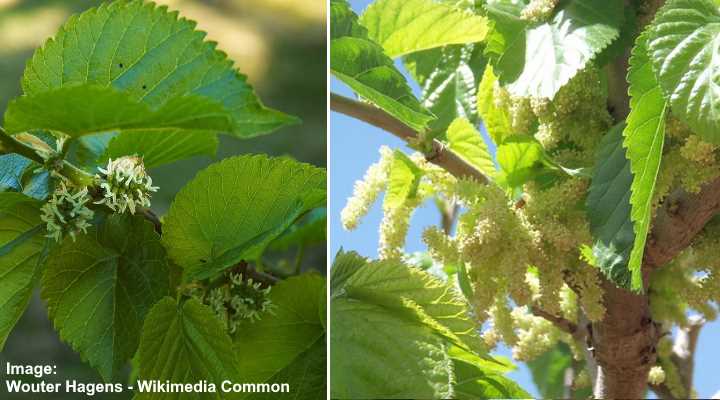
Mulberry female flowers (left) and male flowers (right)
Mulberry tree blooms are tiny white or green blossoms that grow on a short spike or catkin. They are insignificant clusters of flowers. Mulberry trees are tiny spikey blossom clusters that bloom in the spring. Wider and longer than female flowers. A single mulberry tree can produce both male and female flowers, but only female flowers bear fruit.
A tree may only bear male or female blossoms. Mulberry blooms turn into a cluster of tiny, seeded fruits that form the berries after blooming in May.
Mulberry Identification
Mulberry trees can be identified by their leaves, fruit, and bark. The heart-shaped leaves with serrated margins and a pointed tip are used to identify mulberry. Mulberries have red, purple, white, or black berries that are easily identifiable. Mulberries are the last trees to shed their leaves in landscapes.
Types of Mulberry Trees
Six common types of mulberry trees will be examined in depth. We’ll examine some popular cultivars for planting in your yard, in addition to the usual red, white, and black types of mulberries.
White Mulberry (Morus alba)

The white mulberry is a fast-growing deciduous tree with white bark. Glossy dark-green tooth-lined leaves, tiny green flower spikes, sweet berry-like fruits, and black furrowed bark distinguish it. The crown of white mulberries is spreading and uneven, sometimes reaching the length of the tree. In full sun, the white mulberry grows in USDA zones 4 through 8.
Because of its large-leafed foliage, the hardy tree grows between 30 and 50 feet (9 and 15 meters) tall and broad. The tree thrives in outdoor settings, although it may be untidy and has limited decorative appeal.
A windbreak, soil erosion management, or grown for its fruits are some of the other uses for a white mulberry tree in a large front or backyard. Silkworm mulberry is another name for the white mulberry. This plant was developed to feed silkworms and is named after its origin in China.
The common mulberry is another name for the red mulberry variety; however, it is often referred to as the common mulberry. The color of the edible berries isn’t what makes the white mulberry name. White, pink, dark red, and deep purple drupes are available.
White mulberries may be differentiated from black and red mulberries in a variety of ways. White mulberry leaves are glossier than red mulberry leaves, first and foremost. Furthermore, unlike black and red mulberries, the fruit is sweet but not particularly powerful.
Mulberry leaves: Heart-shaped white mulberry leaves have serrated, unequal edges. The leaves are up to 8 inches (20 cm) long and have two or three uneven lobes. The mulberry leaves turn an unpleasant yellow or light brown color in the autumn.

White mulberry leaf
Mulberry fruit: In the summer, white mulberry drupes turn pink, red, or purple-black. These 1-inch (2.5-cm) long drupes are edible. White mulberries have a dull flavor when compared to black and red mulberries.
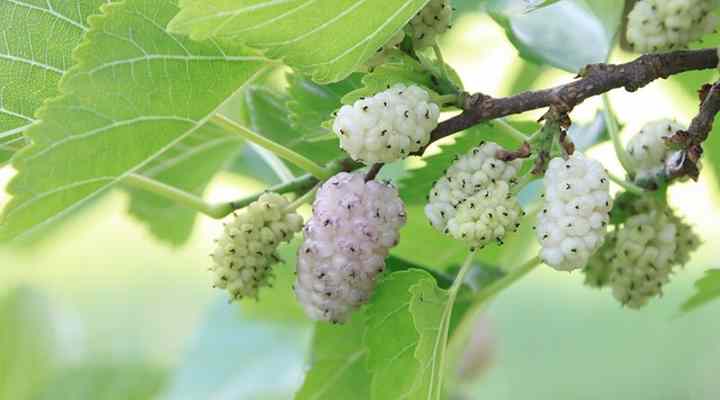
White mulberries mature to pink, red or purple-black fruits
Mulberry flower: Catkins are the term for both male and female blooms. Yellowish-green male catkins are about ¾ to 2 inches (2 to 5 cm) long. Green female catkins have shorter, more oval white ‘hairs.
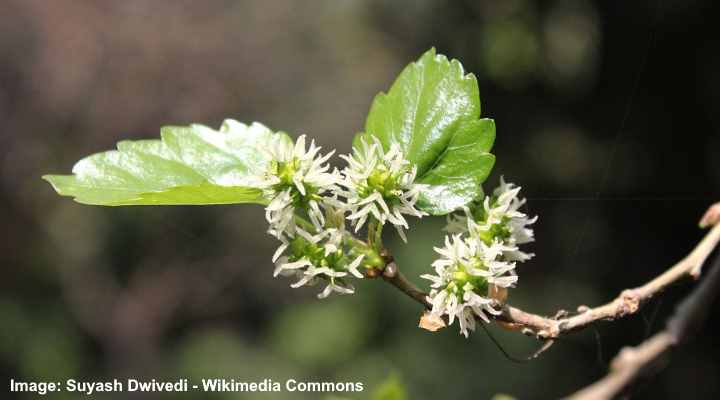
White mulberry female flowers
Red Mulberry (Morus rubra)

The red mulberry (Morus rubra) is a North American native that grows to be about 20 feet tall. The tree is distinguished by large ovate-shaped dark-green lobed leaves, delicious edible berries, tiny cylindrical greenish blooms, and smooth reddish-brown bark. It’s also known as common mulberry.
The tree’s wide spherical crown is visible in landscapes. Full sun is ideal for red mulberry trees, but partial shade is also acceptable. The hardy tree is well-known for its sweet and delicious soft fruits, which are suitable for USDA zones 4 to 8. Mulberry plants attract butterflies, birds, and other creatures because of their flowers and fruit.
From April to May, tiny greenish catkins of red mulberry bloom. Among the huge, broad leaves, the little tubular blooms grow up to 1″ (2.5 cm) long. The smooth, dark brown to dark gray bark of red mulberry is Shallow reddish-colored ridges may form on the tree bark. The reddish-brown color of branches and stems is a common sight.
The distinctive leaves of the red mulberry are a distinguishing characteristic. The heart-shaped leaves of the red mulberry have a rounded base. Yet, the green blade can be uneven due to the presence of numerous deep lobes on leaves. Simple birch tree leaves with a pointed tip or deeply lobed leaves like a maple tree are examples of leaves.
Mulberry leaves: The finely-toothed margins of red mulberry tree leaves are cordate shaped. Leaves might be hairy and have several lobes or no lobes. The leaves of red mulberry are 6 to 15 inches (15 to 30 cm) long and 3 to 6 inches (7.5 to 15 cm) broad.
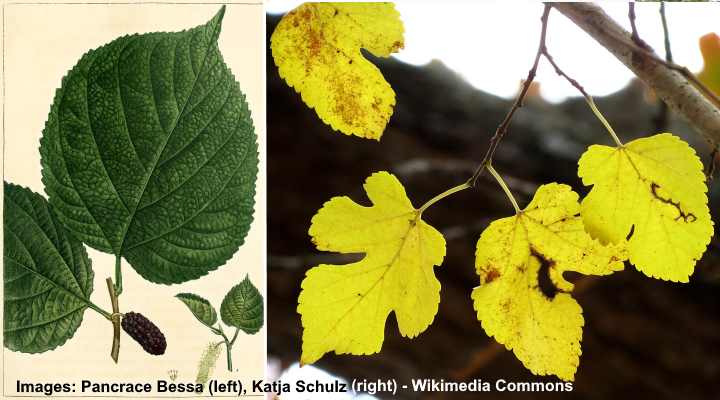
Red mulberry leaves
Mulberry fruit: Sweet and succulent, red mulberry tree berries resemble huge blackberries. Mulberry fruits turn dark purple as they approach maturity. They are ready to eat in the summer.
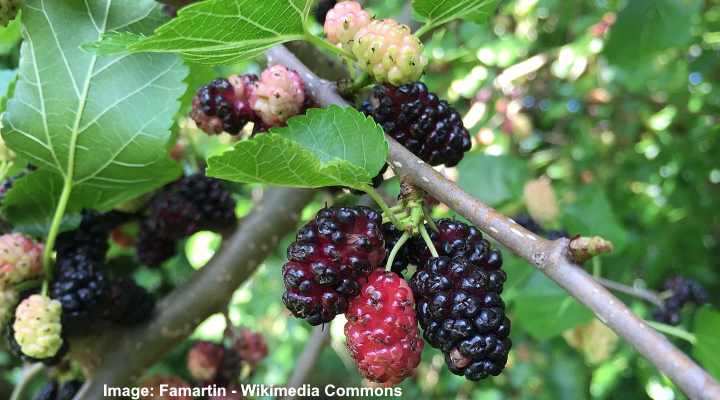
Red mulberry fruit
Black Mulberry (Morus Nigra)

The black mulberry is the tiniest of the common mulberry trees, measuring just a few feet tall. Pointed ovate dark-green leaves, greenish blooms, and red, white, or black fruit distinguish black mulberries in landscapes. The black mulberry has the most bushiest growth of all mulberry species.
The black mulberry thrives in full sun and may be found growing from USDA zone 5 to 9. The black mulberry, unlike the other brown mulberries, is shade-tolerant but not cold-tolerant.
Little tubular white flowers make up black mulberry catkins, which are inconspicuous. In the spring, the mulberry tree flowers. The delectable edible berries develop later in the summer after blooming.
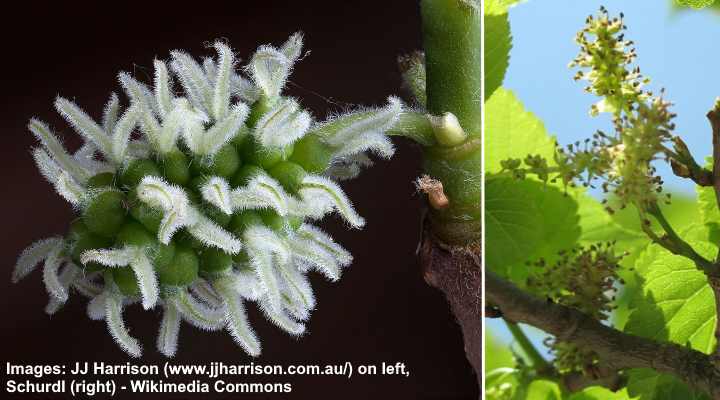
The bark of the black mulberry tree is light-brown in color with thin fissures. It has female (left) and male (right) flowers. The trunk may grow gnarls and enormous burrs over time. As the tree loses its leaves in the winter, the beautiful bark texture adds extra winter appeal.
Mulberry leaves: The broad, simple leaves of the black mulberry tree grow 4″ to 8″ (10 cm) long and up to 4″ (10 cm) broad. Mulberry leaves have a rough feel, stiff hairs, and finely serrated edges that differentiate them from other types of leaves.

Black mulberry leaf
Mulberry fruit: Little black drupes that are 1.2 inches (3 cm) long make up the black mulberry tree berries. The crimson mulberry berries-shaped fruits have a rich, tangy flavor.

Black mulberry fruit
Weeping Mulberry (Morus alba ‘Chaparral’ and Morus alba ‘Pendula’)

Weeping mulberry trees (Morus alba ‘Pendula’) are attractive landscaping trees with arching branches that slope to the ground. The heart-shaped leaves and sweet edible white or pink fruits of the weeping mulberry give it a neat, rounded crown. Small gardens and specimen plants may be grown with weeping mulberries.
They have the same leaf, bark, and fruit identification characteristics as white mulberries because most weeping mulberries are cultivars of Morus alba. The only distinction is in terms of height. They have shorter stature while weeping. The weeping mulberry cultivars Morus alba, aka white mulberry:
Morus alba ‘Chaparral’ With a spherical, spreading canopy and drooping branches, this is a fruitless weeping mulberry tree. The 6 to 8 foot (1.8 – 2.4 m) tall and 12 foot (3.6 m) broad mulberry cultivar thrives in the garden. Male catkins on this tree are yellowish-green and don’t produce fruits.
Morus alba ‘Pendula’ The sweet blackberry-like white, red, or purple fruits and glossy dark-green pointed ovate leaves are characteristic of this fruiting weeping mulberry tree. The weeping mulberry ‘Pendula’ grows to be 6 to 10 feet (1.8 to 3 meters) tall and broad.
Mulberry leaves: Serrated uneven margins and two to three lobes are common features of weeping mulberry tree leaves. The apex of the rounded leaves is pointed, and they have a lustrous green sheen.
Mulberry fruit: Sweet, cylindrical drupes up to 1″ (2.5 cm) long hang from the weeping mulberry tree berries. The berries are sweet, but they lack the intensity of black or red mulberry fruits. They are white, pink, red, or black.
Fruitless Mulberry (Morus alba ‘Fruitless’)

Fruitless mulberry trees have broad, heart-shaped pointed, glossy green leaves and light orange-brown bark. They produce small greenish flower clusters. Because they are easy to cultivate, require minimal pruning, and don’t produce messy fruit, fruitless mulberries are ideal for landscaping. In addition, the fruiting types of mulberries are less invasive.
The Morus alba ‘Fruitless’ cultivar is a good choice if you’re looking for an attractive mulberry tree that isn’t overly messy. This mulberry tree grows to be 20 to 60 feet (6 to 18 meters) in height and width.
Some non-berry producing mulberry cultivars may be found below:

Morus alba ‘Fegyverneken’
- White mulberry ‘Fegyvernekiana’—grows up to 4 ft. (1.2 m) high.
- White mulberry ‘Bellaire’—a medium-sized mulberry growing 30 to 50 ft. (5 – 15 m) tall.
- White mulberry ‘Hempton’
- White mulberry ‘Urban’
- White mulberry ‘Stribling’—grows 30 to 50 ft. (5 – 15 m) high.
Dwarf Mulberry Tree

The dwarf mulberry tree, which thrives in containers and garden settings, is a shrub-like plant. The dwarf variety has leathery green leaves, dark red or black summer fruits, and smooth brown or gray bark, as do other mulberries. A multi-stemmed shrub-like tree or a single-stemmed specimen tree might be called a dwarf mulberry.
Dwarf mulberries can be grown in pots. A small mulberry grows 2 to 6 feet (0.6 to 1.8 meters) tall when grown in pots and pruned correctly. In a well-draining potting soil, grow in full sun. The everbearing mulberry is a kind of dwarf mulberry tree that is smaller than the conventional variety.
The dwarf variety grows to be between 10 and 15 feet (3 and 4.5 meters) tall and broad. The dwarf everbearing mulberry bears succulent red or black berries, as do other mulberries.
Miniature mulberry bonsai trees are also available. Mulberry bonsai trees have gnarled branches, small pointed ovate leaves, and produce medium-sized fruits.
